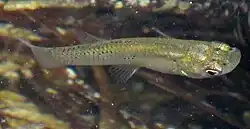Gambusia yucatana
| Yucatan Gambusia | |
|---|---|

| |
| Scientific classification | |
| Kingdom: | Animalia |
| Phylum: | Chordata |
| Class: | Actinopterygii |
| Order: | Cyprinodontiformes |
| Family: | Poeciliidae |
| Genus: | Gambusia |
| Species: | G. yucatana
|
| Binomial name | |
| Gambusia yucatana Regan, 1914[2]
| |
| Synonyms | |
| |
Gambusia yucatana is a species of fish of the ray-finned fish family, the Actinopterygii, and the order of the Cyprinodontiformes, which are mostly small, freshwater fish.[4]
Description
Males can reach 5.5 cm (2.17 in) in total length and females are reported reaching 8 cm (3.15 in).[5] The species are internal livebearers -- their eggs hatch inside the females, and the young are born directly into the water.
Distribution
Yucatan Gambusia occurs in Mexico's Yucatan Peninsula as well as Belize and northern Guatemala.[5]
Habitat
Gambusia yucatana is described as living in fresh water, and as benthopelagic, the latter term referring to fish inhabiting water just above the water's bottom, feeding on benthic zone organisms and zooplankton.[5] However, the fish illustrated in the taxonomy bar was observed where brackish water of an estuary flowed into the somewhat less brackish water of a mangrove swamp,[6] so the species appears to tolerate a little salt.
Taxonomy
In 1914, Gambusia yucatana was introduced to science by Charles Tate Regan, in a work entitled "Descriptions of two new cyprinodont fishes from Mexico, presented to the British Museum by Herr A. Rachow." That original description can be viewed online, on page 67, at the Biodiversity Heritage Library[7] There it's seen that four type specimens were taken at Progreso, Yucatán.
Etymology
The genus name Gambusia derives from the Cuban term, Gambusino, which means "nothing", usually in the context of a joke or a farce -- as when one catches gambusinos, not really catching much of anything.[5]
The species name yucatana honors the Yucatan Peninsula where it mainly occurs.
Similar species
Gambusia yucatana can be confused with the Caribbean Gambusia, Gambusia puncticulata[8] (dark stripe under eyes) and the Pike Topminnow, Belonesox belizanus[9] (extended pointed snout; prominent spot at base of caudal fin).[10]
Conservation status
The IUCN Red List of Threatened Species in 2019 considers Yucatan Gambusias as species of least concern.[1]
However, considering the Yucatan's large population centers, as in Mérida and Cancún, and the peninsula's karst topography in which groundwater flows through numerous interconnected channels in the limestone rock relatively quickly,[11] the species may be negatively affected by contaminated groundwater. A study of the effects of organochlorine pesticide concentrations in a canal draining through the city of Campeche, Mexico found that the compounds may have estrogenic effects on Yucatan Gambusia. Up to 16 organochloride compounds from such sources as Aldrin concentrate in the species, and the higher the compound concentrations, the lower the male Yucatan Gambusia's sperm count.[12]
Gallery
-
_-_Tulum_QR.jpg) In Tulúm, Quintana Roo
In Tulúm, Quintana Roo
References
- ^ a b Collette, B.B.; Grubbs, D.; Pezold, F.; Simons, J.; Caruso, J.; Carlson, J.; McEachran, J.D.; Brenner, J.; Tornabene, L.; Chakrabarty, P.; Robertson, R.; Arroyave, J.; Lyons, T.J. (2019). "Gambusia yucatana". IUCN Red List of Threatened Species. 2019: e.T191731A2000138. doi:10.2305/IUCN.UK.2019-2.RLTS.T191731A2000138.en. Retrieved 3 July 2025.
- ^ Eschmeyer, William N.; Fricke, Ron & van der Laan, Richard (eds.). "Species related to Gambusia yucatana". Catalog of Fishes. California Academy of Sciences.
- ^ "Synonyms of Gambusia yucatana Regan, 1914". fishbase.se. Swedish Museum of Natural History. Retrieved August 16, 2025.
- ^ "Cyprinodontiformes L.S.Berg, 1940". Global Biodiversity Information Facility. Retrieved August 16, 2025.
- ^ a b c d Froese, Rainer; Pauly, Daniel (eds.). "Gambusia yucatana". FishBase. August 2025 version.
- ^ "Caribbean Gambusia (Gambusia puncticulata)". inaturalist.org. 10 August 2024. Retrieved August 16, 2025.
- ^ Regan, C. Tate (1914). "Descriptions of two new cyprinodont fishes from Mexico, presented to the British Museum by Herr A. Rachow". The Annals and Magazine of Natural History; Zoology, Botany, and Geology. 14. Taylor and Francis, Ltd: 65–67.
- ^ "Caribbean Gambusia (Gambusia puncticulata)". inaturalist.org. Retrieved August 16, 2025.
- ^ "Pike Topminnow (Belonesox belizanus)". inaturalist.org. Retrieved August 16, 2025.
- ^ Snow, John. "Yucatán Gambusia". mexican-fish.com. Retrieved August 16, 2025.
- ^ Gelting, RJ (1995). "Water and Population in the Yucatan Peninsula; IIASA Working PaperWP-95-087" (PDF). Laxenburg, Austria: International Institute for Applied Systems Analysis. Retrieved August 16, 2025.
- ^ Chi-Uc, L.; Ortíz, A.; Memije, M.; Soares, A.M.V.M.; Rendón-von Osten, J. (Jan–Dec 2009). Plaguicidas Organoclorados y Biomarcadores de Efecto Estrogénico e Gambusias Machos (Gambusia yucatana) de la Ría de San Francisco de Campeche, México (PDF). Biologist (Lima) (in Spanish). Scientific Platform Presentations. pp. 60, 61. Retrieved August 16, 2025.
Bibliography
- Lucinda, P.H.F.: Poeciliidae (Livebearers). Páginas 555-581. En: R.E. Reis, S.O. Kullander & C.J. Ferraris, Jr. (eds.): Checklist of the Freshwater Fishes of South and Central America. Ed. EDIPUCRS, Porto Alegre, Brasil. 2003.
- Moyle, P. y J. Cech.: Fishes: An Introduction to Ichthyology, 4ª edición, Upper Saddle River, Nueva Jersey, Estados Unidos: Prentice-Hall. 2000.
- Nelson, Joseph S.; Grande, Terry C.; Wilson, Mark V. H. (2016). Fishes of the World (5th ed.). Hoboken: John Wiley and Sons. doi:10.1002/9781119174844. ISBN 978-1-118-34233-6.
- Wheeler, A.: The World Encyclopedia of Fishes, 2ª edición, Londres: Macdonald. 1985.
